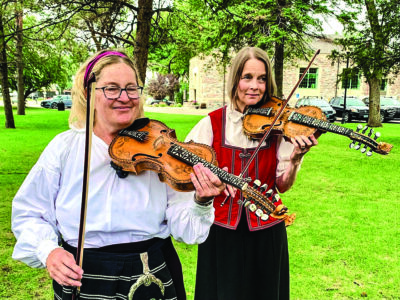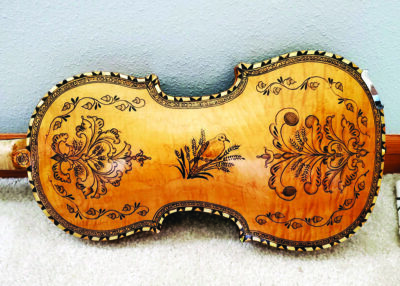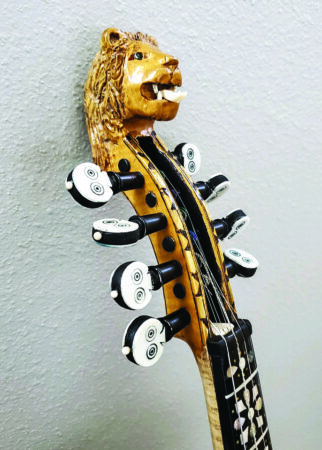Nancy Edmonds Hanson
- Lisa Stein and Julianne Overby of Moorhead play traditional Scandinavian dance tunes with the local Spelemannslag musical ensemble. (Photos/submitted.)
- Delicate original sketches decorate the back of every Hardanger fiddle.
- Bud Larsen topped Julianne Overby’s Hardanger fiddle with a scroll in the shape of a lion’s head in honor of her years at St. Olaf College.
Once banned as “the instrument of the devil,” the Hardanger fiddle is coming back to life … and that’s a blessing.
Three Moorhead women are among the dozen or so musicians who make up the Fargo Spelemannslag, the troupe of players in traditional Norwegian garb who often perform at ethnic festivals. The colorful ensemble will next share their mastery of the traditional musical art in a concert at the Hjemkomst Center on Dec. 2.
Lisa Stein, Julianne Overby and Rinata Dalan not only play the distinctive eight- or nine-stringed instruments. They are among a handful of local musicians who are now learning to craft their own as apprentices of master luthier (maker of stringed instruments) Robert “Bud” Larsen of Brainerd. Lisa and Julianne have been cutting and sanding and shaping their fiddles since the beginning of the year in workshops – in person and on Zoom – funded by the Lake Region Arts Council and Minnesota Arts Board. Rinata got a head start on hers, along with fellow apprentice Steve Lindaas, in the North Dakota Council on the Arts Folk Arts Apprenticeship in previous years.)
They two Moorhead apprentices are looking at another year or two of painstaking craftsmanship under Larsen’s expert guidance. In the meantime, though, both Lisa and Julianne perform with the Spelemannslag, playing fiddles they purchased from the master in weekly practice sessions and festival performances.
Don’t mistake the Hardanger fiddle for a violin, Julianne cautions. Though the violin’s basic outline bears a resemblance, the folk instrument, which dates back at least to the 1600s, both the Hardangfele’s shape and embellishments set it apart. Its body of imported maple and spruce is richly decorated with Norwegian-style rosetegning, or rose-sketching. The neck or fingerbrett (fingerboard) is inlaid with a pattern of abalone or mother of pearl. The fanciful scroll at its top may be a dragon, an eagle, a troll or some other creature that suits its maker’s fancy. The bridge is flatter than a violin’s, too, and the F holes on its face are curved rather than flat.
But it’s the sound that truly sets these fiddles apart. Strings are set at two levels – four above that are stroked by the bow, with four or five below them. The lower strings resonate, creating a bigger sound that reverberates and lingers. The tuning, too, is different. Instead of a single standard, the musician may choose from 25 versions depending on the song to be played, whether polka, waltz or another lively dance tune – usually playing by ear, though some transposed sheet music is available.
Julianne, who moved to Moorhead 10 years ago after retiring from St. Olaf College, had played the violin from the age of 7 and continued to play it in college, where a professor introduced the folk instrument. She commissioned Bud Larsen to build her fiddle, topped with a lion’s head scroll in honor of the St. Olaf mascot. Reconnecting with other enthusiasts after moving to Moorhead 10 years ago, she began playing with several Fargoans who’d met through the North Dakota Council on the Arts’ apprenticeship. The Spelemannslag has been practicing and performing together ever since 2016.
Lisa is a more recent convert to the Hardangfele. “I heard about the fiddles from my pastor’s wife and thought, ‘That sounds like fun,’” she remembers. She began playing in 2020 after purchasing her own fiddle from the group’s mentor, one built by a Norwegian farmer in the 1930s.
Apprentices gather at In the Chips, the Moorhead woodworking studio, to carve, shape and finally decorate their instruments. Neither woman had woodworking experience. “We’re pretty green at this,” Julianne confesses. “We’re starting from scratch.” Larsen advised carving wooden spoons to get their feet wet.
They’ve met for several two-day workshops, the next coming up Nov. 30, plus occasionally in members’ basements. “Otherwise, we’re on our own,” Lisa points out. The process, which takes their mentor around 200 hours, is predicted to take them a minimum of two years.
They have come a long way. After cutting shapes and strips from wooden planks, the strips are soaked, warmed with what she likens to a “medieval blowtorch,” then bent to match the curves of a pattern, clamped with countless clothespins and left to cure. The graceful arcs of the front and back are shaped with scrapers and sandpaper. Strings of steel and gut, longer than those of a violin, are ordered from the Hardanger Association of America.
The final step, decorating the instrument, is where artistry and personal taste come together. Every Hardanger fiddle is truly unique, with elaborate Norse-style sketching and patterns of bone and shell inset on the fingerboard and the instruments edges.
About that folk belief of devilish influence: It can be traced to the stern Lutheran revival that swept Norway in the early and mid-1800s, led by Hans Nielsen Hauge. In folk tales the devil is associated with the fiddles; good players were said to have been taught to play by the devil himself. Fiddles were often hidden or even burned during the religious fervor, considered “sinful instrument that encouraged wild dances, drinking and fights.”
“Dancing was the real sin,” Julianne suggests. “The music led to dancing, drinking and general carousing.”
Thus it’s no surprise that the tradition was in danger of dying out in the 20th century until its revival as a valuable folk art worth celebrating. Teacher Larsen learned the craft of building fiddles from a neighbor, Gunnar Helland, when his family moved to Fargo. He worked with Helland, a fourth-generation fiddlemaker, throughout his youth, mastering the principles that undergird the Hardanger tradition.
After serving as a missionary in Papua New Guinea with Wycliffe Bible Translators, Larsen returned to Brainerd, where he established an instrument shop in 1991. He estimated he has built 400 Hardangfele since then. He has also conducted workshops and offered apprenticeships throughout the region. He has no plans to retire: “Retirement? You have to have a real job to retire,” he laughs.
The Historical and Cultural Society of Clay County is hosting his next visit to Moorhead at the end of the month. The Spelemannslag concert on Saturday, Dec. 2, will feature the local musicians and nationally known fiddler Loretta Kelley, president of the Hardanger Fiddle Association of America.





